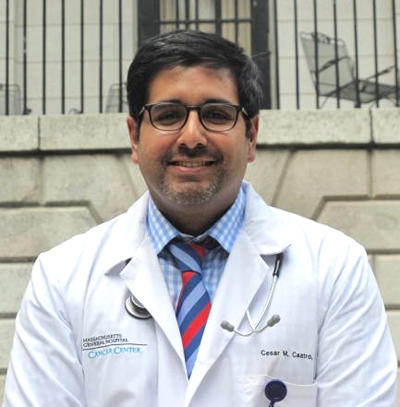CURE Spotlight: Cesar Castro, M.D. Develops Smartphone Technology for Cancer Detection in Underserved Communities
, by CRCHD Staff
Cesar Castro, M.D., a former K12 CURE scholar and now Director of the Cancer Program at Massachusetts General Hospital Center for Systems Biology, and a team of researchers have developed a smartphone-based technology that converts a smartphone into a tool for cancer diagnosis.
The device called the Digital Diffraction Diagnosis System or “D3” is what Castro describes as a “forward thinking nanotechnology platform that allows us to extract clinical and scientific information from small amounts of tissues.”
D3 operates as an attachable device that clips to a standard smartphone. It consists of an imaging module with a battery-powered LED light capable of producing and recording high-resolution images using the smartphone’s camera. With a field of view greater than traditional microscopy, the D3 can record data on more than 100,000 cells from a single tissue sample or prick of blood. Preliminary data collected from the device also appears to be more accurate than other cancer detection tests currently used.
The smartphone device, Castro says, “is particularly advantageous in remote areas of the world like Botswana, Africa, where you may have only five pathologists in the entire country, a huge backlog of pathology lab tests, and few specially trained people to obtain tissue samples.” The device can “get far quicker results than in a regular hospital center setting where it can take a couple hours or even days for the pathology lab to conduct the tests,” reports Castro. The D3 device is also less expensive than other detection tests; one test costs $1.80 and can be used from any smartphone.
“I am passionately interested in leveraging novel nanotechnology-driven diagnostic and profiling strategies to enhance cancer research and care,” Castro said. He developed the technology to help mitigate a perception that a lot of advances from the nanotechnology field, or cancer research field, are ones made at the bench-side and don’t necessarily translate at the bedside. “This caused me to think about the fundamental barriers between new technologies and widespread adoption – at the medical center level, at the provider level, and at the patient level,” he explained. “This state-of-the-art thinking is what we can bring to people who really need it but can’t access it.”
Castro and his team tested the effectiveness of the device by conducting a pilot analysis of cervical biopsy samples from 25 women with abnormal PAP smears. The D3 device analyzed and categorized the biopsy samples (based on the number of microbeads tagged with antibodies against three published markers associated with precancerous or cancerous cervical changes) and found that the D3 analysis promptly and reliably categorized biopsy samples as high-risk, low-risk or benign, with results matching those of trained clinical pathologists.
Castro’s team then conducted a second test on eight patients with suspected lymphomas due to enlarged lymph nodes. Study results, published in the Proceedings of the National Academy of Sciences, indicated that the technology was able to accurately differentiate the benign and lymphoma cases. However, more tests are still needed on a larger number of cancers to verify these preliminary findings.
As a former K12 CURE supplement grantee, Castro’s initial work centered on a novel magnetic-resonance platform to detect and examine proteins using nanoparticles and advanced chemistries. A smartphone app was developed to help interface with the external platform. The national and international attention on the potential mobile applications of that work catalyzed his current push to miniaturize diagnostics platforms into fully mobile approaches, such as the D3 device, while maintaining the protein focus of his CURE work.
He credits some of the success of his D3 device to participation in CRCHD’s CURE program, which offers unique training and career development opportunities to enhance and increase diversity in the cancer and cancer health disparities research workforce. Now, as an experienced investigator, he serves as a mentor to other students and trainees within or beyond the Harvard Medical School system.
When asked about his future plans, Castro said he is working towards getting the D3 device “to be field-tested in a global scenario.” His team has applied for an NIH program grant to leverage an existing partnership in Botswana. Castro hopes “to expand the use of the technology to diagnose lymphoma in Botswana, which is an HIV-related cancer prevalent in the region.”
